
What is a Home Hospital Bed Called? Types and Terminology Explained
📋 KEY TAKEAWAYS
| Terminology | Description | Key Features |
|---|---|---|
| Homecare Bed | Most common residential term | Medical functions with home-friendly design |
| Home Medical Bed | Clinical terminology | Full medical features, often Medicare-covered |
| Home Hospital Bed | Generic descriptive term | Adjustable positions, medical-grade durability |
| Residential Medical Bed | Aesthetic-focused term | Less institutional appearance, home design |
Most Common Industry Term: Homecare Bed – The standard terminology used by medical suppliers
For Insurance/Medicare: Home Medical Bed – Terminology often used in clinical documentation
For Large Individuals: Bariatric Homecare Bed – Specialized term for heavy-duty models
A home hospital bed is most commonly called a "homecare bed" or "home medical bed" in the healthcare industry.
These terms refer to medical-grade beds designed for residential use that provide the clinical functionality of hospital beds while featuring more home-friendly aesthetics. Other common terms include residential hospital beds, home health beds, and medical beds for home use.
Understanding the correct terminology for hospital beds used at home can be crucial when researching options, communicating with healthcare providers, or filing insurance claims. This guide will clarify the various terms used for these specialized beds and explain the key differences between them.
Common Terminology for Hospital Beds Used at Home
The healthcare industry and medical suppliers use several terms interchangeably when referring to hospital-style beds designed for home use.
| Term | Usage Context | Typically Refers To |
|---|---|---|
| Homecare Bed | Industry standard, medical suppliers | Full-featured medical beds designed specifically for home use |
| Home Medical Bed | Clinical documentation, insurance | Medicare-eligible beds with full medical features |
| Home Hospital Bed | General consumer term | Any medical-grade bed used in a residential setting |
| Residential Hospital Bed | Interior design, aesthetic focus | Medical beds with enhanced home-friendly appearance |
| Home Health Bed | Healthcare providers | Beds prescribed as part of home health services |
Homecare Bed
"Homecare bed" is the most widely used industry term among medical equipment suppliers and healthcare professionals. This terminology specifically refers to medical-grade beds designed with home use in mind, featuring:
- Full electric or semi-electric adjustment capabilities
- Height adjustability for transfer safety and caregiver access
- Medical-grade frame durability
- Home-friendly design elements to blend with residential settings
- Compatibility with home medical mattresses
Many suppliers list these products under "homecare beds" as the primary category. This term is particularly common when referring to beds that balance medical functionality with design considerations for home environments.
Home Medical Bed
The term "home medical bed" is often used in clinical contexts and insurance documentation. This terminology emphasizes the medical functionality of the bed rather than its residential design elements.
Key characteristics of home medical beds include:
- Full compliance with medical device regulations
- Medicare and insurance eligibility when prescribed
- Clinical positioning capabilities (Trendelenburg, etc.)
- Integration with medical equipment and accessories
- Emphasis on therapeutic features over aesthetics
This terminology is particularly important when filing for Medicare coverage, as the documentation typically requires specific medical justification for a "home medical bed" rather than a regular adjustable bed.
Home Hospital Bed
"Home hospital bed" is a general descriptive term that consumers often use when searching for these products. It's a straightforward way to describe the concept: a hospital-style bed designed for use in a home environment.
While less common in industry classification, this term effectively communicates the dual nature of these products:
- The clinical functionality of hospital beds
- Adaptation for residential use
- Adjustable features similar to those found in medical facilities
- Design modifications for home aesthetics
- Focus on both patient and caregiver needs
This terminology is frequently used in general consumer searches and discussions but may be less common in formal industry classifications.
Residential Medical Bed
The term "residential medical bed" places greater emphasis on the home-friendly aesthetic aspects while maintaining medical functionality. These beds typically feature:
- Designer headboards and footboards
- Furniture-quality finishes
- Concealed medical components
- Color options beyond institutional white
- Integration with home décor
This terminology is particularly common among premium manufacturers who focus on creating medical beds that closely resemble traditional bedroom furniture while maintaining full clinical functionality.
Specialized Types of Home Hospital Beds
Beyond the general terminology, several specialized types of home hospital beds have their own specific nomenclature.
Bariatric Home Hospital Beds
Bariatric hospital beds designed for home use have specific terminology that indicates their heavy-duty capabilities. Common terms include:
- Bariatric homecare bed: The most common industry term
- Heavy-duty home medical bed: Emphasizes structural reinforcement
- Bariatric home hospital bed: General consumer terminology
- Wide-width medical bed: Focuses on dimensional aspects
- High-capacity residential hospital bed: Emphasizes weight capacity
These specialized beds typically feature:
- Enhanced weight capacities (500-1000 pounds)
- Wider sleep surfaces (42"-60")
- Reinforced frames and support structures
- Heavy-duty motors and electronics
- Specialized bariatric mattress compatibility
Low/Ultra-Low Home Hospital Beds
Home hospital beds designed specifically for fall prevention have specialized terminology that highlights their minimal height capabilities:
- Low profile homecare bed: Indicates lower minimum height
- Ultra-low home medical bed: Emphasizes extremely low positioning
- Floor-level hospital bed: Describes beds that lower very close to the floor
- Fall prevention medical bed: Focuses on safety function
- Height-adjustable homecare bed: Emphasizes range of motion
These specialized beds feature minimum heights ranging from 3.9" to 10" from the floor to minimize injury risk should falls occur.
Hi-Lo Home Hospital Beds
Beds that emphasize their height adjustment range use terminology that highlights this capability:
- Hi-Lo homecare bed: Standard industry term
- Height-adjustable medical bed: Descriptive functional term
- Variable height hospital bed: Technical terminology
- Adjustable height home medical bed: Consumer-friendly description
- Elevation-capable residential bed: Premium marketing terminology
These beds typically feature height ranges from 7"-30", allowing for both low transfer heights and elevated caregiver access heights.
Medical vs. Consumer Terminology Differences
The terminology used for home hospital beds differs between medical professionals and consumers, which can sometimes create confusion.
| Medical Industry Term | Common Consumer Term | Key Difference |
|---|---|---|
| Semi-electric homecare bed | Semi-automatic hospital bed | Technical vs. familiar terminology |
| Full-electric medical bed | Power hospital bed | Clinical vs. descriptive language |
| Hi-Lo homecare bed | Adjustable-height medical bed | Industry shorthand vs. descriptive term |
| Long-term care bed | Home nursing bed | Clinical setting vs. function description |
| Bariatric medical bed | Heavy-duty hospital bed | Medical term vs. descriptive language |
Medical Industry Terminology
Healthcare professionals and medical suppliers typically use precise, technical terminology that reflects:
- Clinical function (Trendelenburg, Hi-Lo, etc.)
- Technical specifications (semi-electric, full-electric)
- Medical classifications (HCPCS codes, DME categories)
- Regulatory compliance language
- Insurance and Medicare terminology
This precision is necessary for medical documentation, insurance claims, and professional communication.
Consumer-Friendly Terminology
When consumers search for and discuss these beds, they often use more descriptive, non-technical language:
- Function-based descriptions ("beds that go up and down")
- Purpose-oriented terminology ("beds for elderly at home")
- Problem-solving language ("beds to prevent falls")
- Familiar terminology from consumer experiences
- Simplified descriptions of medical features
This difference in terminology can sometimes create challenges when consumers attempt to research or purchase medical-grade beds using non-industry terms.
Home Hospital Beds vs. Other Similar Products
Understanding the terminology differences between home hospital beds and similar products helps clarify exactly what constitutes a genuine medical bed for home use.
Home Hospital Beds vs. Adjustable Beds
The terminology difference between medical beds and consumer adjustable beds is significant:
- Home hospital/medical beds: Medical devices with clinical features, often Medicare-eligible
- Adjustable beds: Consumer comfort products without medical certifications or features
Key differences reflected in terminology:
- Medical beds use clinical terminology (Hi-Lo, Trendelenburg)
- Adjustable beds use comfort terminology (Zero-G, anti-snore)
- Medical beds emphasize patient/caregiver terminology
- Adjustable beds emphasize lifestyle/comfort terminology
Home Hospital Beds vs. Long-Term Care Beds
The distinction between home medical beds and institutional long-term care beds is reflected in terminology:
- Homecare/home medical beds: Designed specifically for residential environments
- Long-term care beds: Institutional beds with similar functions but different aesthetics
The primary terminology differences emphasize:
- Residential vs. institutional design language
- Home-friendly vs. facility-focused descriptions
- Consumer vs. institutional durability specifications
Home Hospital Beds vs. Standard Hospital Beds
Standard hospital beds and home hospital beds share many functional similarities but differ in design focus, which is reflected in terminology:
- Home medical/homecare beds: Emphasize residential integration
- Standard hospital beds: Emphasize clinical functionality
Key terminology differences highlight:
- Home-friendly vs. clinical aesthetics
- Residential vs. institutional durability requirements
- Consumer vs. professional control interfaces
Mattress Terminology for Home Hospital Beds
The mattresses designed for home hospital beds also have specific terminology that differs from standard residential mattresses.
The primary term for these specialized mattresses is "hospital bed mattress," but several other terms are also commonly used:
- Homecare mattress: Matches "homecare bed" terminology
- Medical mattress: Emphasizes clinical functions
- Home medical mattress: Combines residential and clinical terminology
- Therapeutic mattress: Focuses on pressure relief and medical benefits
- Articulating mattress: Emphasizes compatibility with adjustable bed functions
These specialized mattresses are segmented into different categories with specific terminology:
- Foam hospital mattresses: Basic supportive surfaces
- Pressure relief mattresses: Designed to prevent pressure ulcers
- Alternating pressure mattresses: Active therapeutic surfaces
- Low air loss mattresses: Manage moisture and temperature
- Bariatric medical mattresses: Reinforced for higher weight capacities
Insurance and Medical Coding Terminology
When dealing with insurance and Medicare coverage, specific terminology becomes critically important.
| Official Terminology | HCPCS Code | Description |
|---|---|---|
| Hospital bed, fixed height, with any type side rails, with mattress | E0255 | Basic manual hospital bed for home use |
| Hospital bed, semi-electric (head and foot adjustment), with any type side rails, with mattress | E0260 | Semi-electric homecare bed |
| Hospital bed, full-electric (head, foot, and height adjustments), with any type side rails, with mattress | E0265 | Full-electric home medical bed |
| Hospital bed, extra heavy duty, extra wide, with weight capacity greater than 600 pounds, with any type side rails, with mattress | E0303 | Bariatric homecare bed (600+ lbs) |
The official Medicare terminology for home hospital beds is "Hospital bed for home use" with various modifiers describing specific features. This terminology appears in:
- HCPCS (Healthcare Common Procedure Coding System) codes
- Medicare LCD (Local Coverage Determination) documents
- Insurance prior authorization forms
- Medical necessity documentation
Using this precise terminology is essential when:
- Filing for Medicare coverage
- Submitting insurance claims
- Obtaining a doctor's prescription
- Documenting medical necessity
Our Top Recommendation for Home Hospital Beds
After analyzing the various terms and products in this category, the Icare Adjustable Electric Home Hospital Bed - IC333 emerges as our top recommendation for a home hospital bed.
This premium homecare bed perfectly balances:
- Medical functionality: Full electric adjustment with Hi-Lo capabilities
- Home-friendly design: Residential appearance that blends with home décor
- Terminology alignment: Properly classified as a Medicare-eligible medical bed
- Safety features: Includes all necessary clinical safety elements
- Long-term value: Durable construction with high-quality components
For those with budget constraints, the Costcare Semi-Electric Bed B120C offers essential medical functionality at a more accessible price point.
For specialized needs, the Ultra Low Hospital Bed Medacure ULB3.9 provides exceptional fall prevention with its ultra-low 3.9" minimum height.
Frequently Asked Questions
What is the difference between a hospital bed and a home hospital bed?
Hospital beds and home hospital beds share the same core medical functions but differ in design focus. Standard hospital beds prioritize clinical durability and institutional use, while home hospital beds (homecare beds) feature more residential aesthetics and design elements suitable for home environments.
Are homecare beds and home hospital beds the same thing?
Yes, "homecare bed" is the most common industry term for what consumers often call "home hospital beds." Both terms refer to medical-grade beds designed for residential use with features like electric positioning and height adjustment.
What is the Medicare terminology for home hospital beds?
Medicare uses "Hospital bed for home use" as the official terminology, with modifiers like "semi-electric" or "full-electric" to specify features. Each configuration has specific HCPCS codes (E0255, E0260, E0265, etc.) for billing and coverage purposes.
What's the difference between a bariatric homecare bed and a standard home hospital bed?
Bariatric homecare beds are reinforced versions of standard home hospital beds designed for higher weight capacities (typically 500-1000 pounds) with wider sleeping surfaces (42"-60"). They feature stronger frames, heavy-duty motors, and reinforced components compared to standard models.
Is a home medical bed the same as an adjustable bed?
No, these are different products. Home medical beds (homecare beds) are FDA-classified medical devices with clinical features like height adjustment, medical-grade durability, and side rails. Adjustable beds are consumer comfort products without medical certifications or healthcare features.
What should I call a hospital bed when getting insurance coverage?
Use the precise Medicare terminology: "Hospital bed for home use" with appropriate modifiers (semi-electric, full-electric, etc.). Include the correct HCPCS code (E0255, E0260, E0265, etc.) and ensure all documentation consistently uses these official terms rather than consumer terminology.
Does the terminology change for different types of home hospital beds?
Yes, terminology varies by feature set. Manual beds are "fixed-height hospital beds," while powered models are "semi-electric" (powered head/foot) or "full-electric" (powered head/foot/height). Specialized beds use additional descriptors like "extra wide," "bariatric," or "low height."










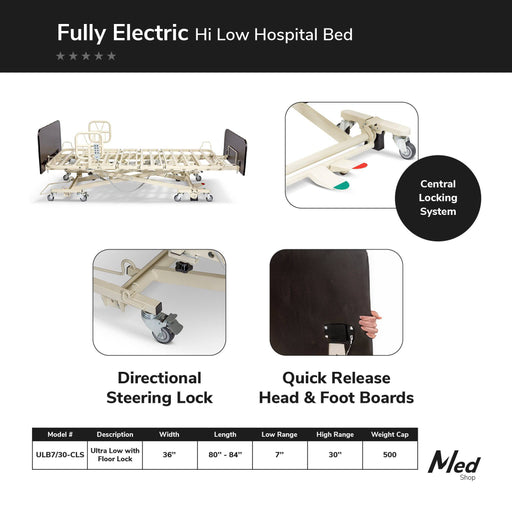
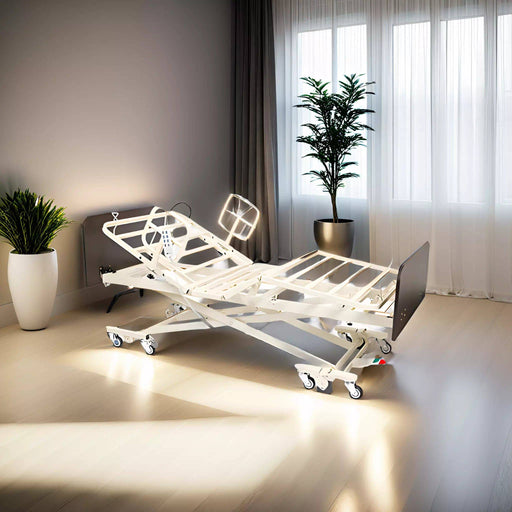



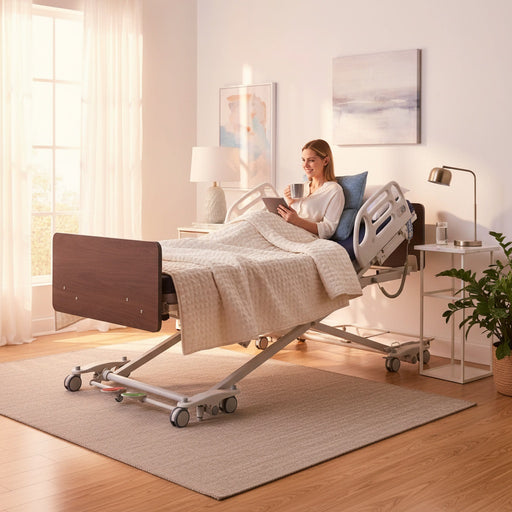
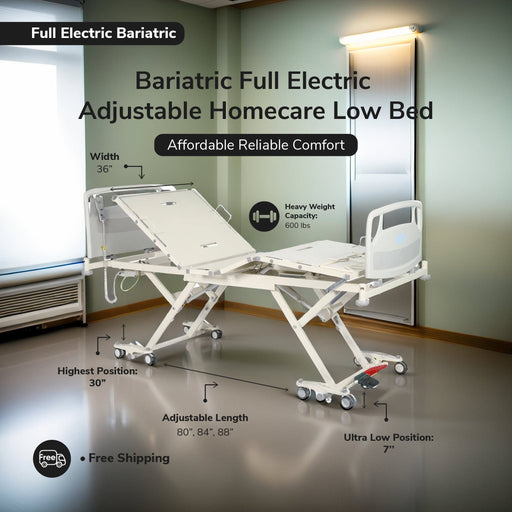
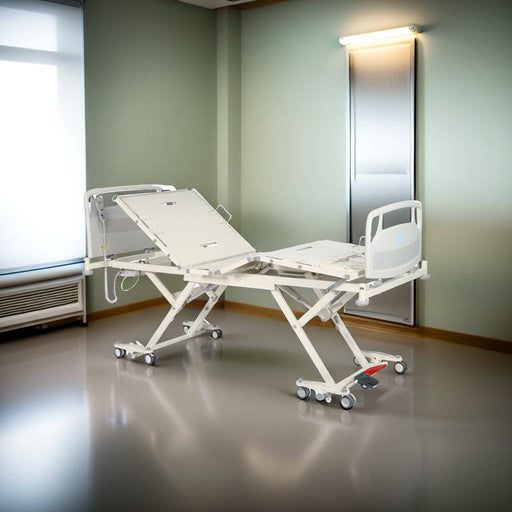
Leave a comment